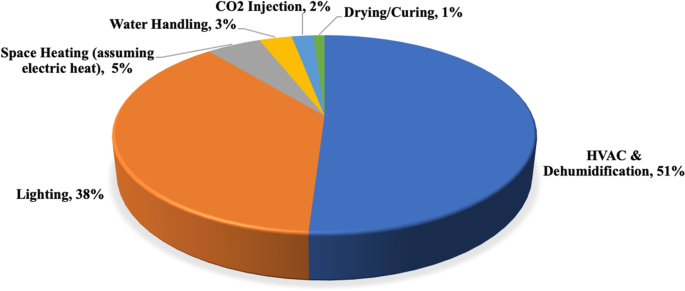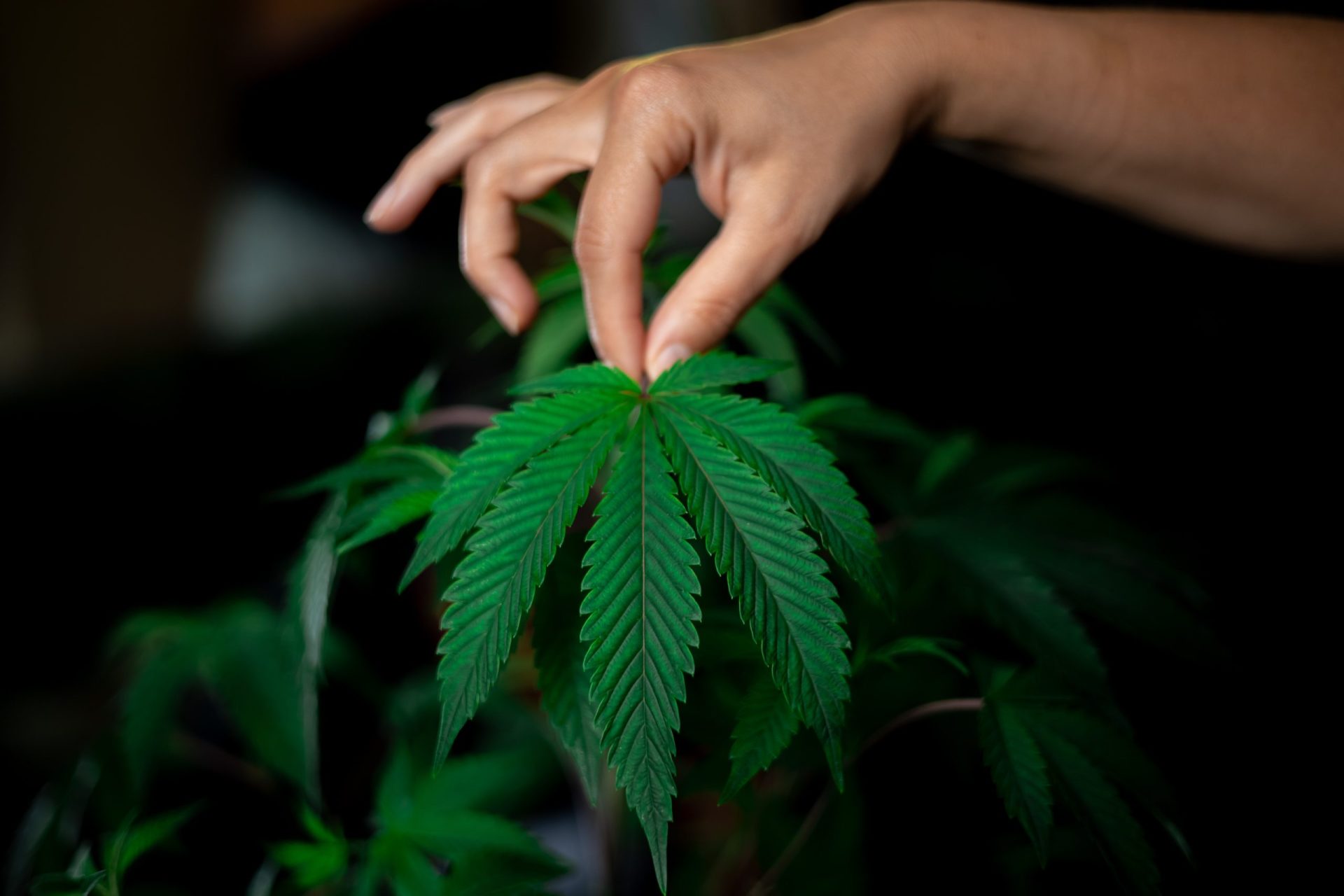Abstract
The growing interest in cannabis cultivation for medicinal and recreational purposes has sparked concerns regarding its environmental footprint. This study provides an extensive review of the environmental impacts associated with both indoor and outdoor cannabis growing practices. Key findings indicate that water-intensive cultivation methods contribute to water pollution and diversion, posing risks to ecosystems. Additionally, cannabis plants release significant amounts of biogenic volatile organic compounds, potentially compromising indoor air quality. Energy consumption is another significant concern, particularly in indoor cultivation, where heating, ventilation, air conditioning, and lighting contribute to greenhouse gas emissions. Moreover, cannabis cultivation can directly contribute to soil erosion, although it also possesses the ability to absorb and store heavy metals. To mitigate these impacts, the adoption of precision irrigation technologies and the implementation of life cycle analysis tools are envisioned as effective measures for reducing water usage and advancing our understanding of the environmental implications of cannabis cultivation.
Background

Cannabis cultivation has a rich history dating back to ancient civilizations and has been used for both medicinal and recreational purposes. The plant contains THC, a psychoactive compound, and CBD, a non-psychoactive cannabinoid with medicinal properties. Despite its widespread use, scientific research on cannabis has been limited due to its legal status in many countries.
Different cultivation methods, such as outdoor and indoor (including greenhouse) cultivation, have varying environmental impacts. Outdoor cultivation is the traditional method but is subject to weather conditions and can lead to environmental issues if not managed properly. Indoor cultivation provides more control but comes with higher costs, energy demands, and associated environmental implications. As global agriculture aims for sustainability, understanding the environmental impact of cannabis farming is crucial.
Given the recent legalization of cannabis in many regions, there is an urgent need for a comprehensive review of its environmental assessment. This review aims to bridge the knowledge gap and provide insights into the environmental impacts of cannabis cultivation. It is intended to benefit various stakeholders, including policymakers, industry professionals, agricultural engineers, ecologists, and environmental scientists. The review focuses on water, air, and soil impacts, as well as energy consumption and carbon footprint. Additionally, potential research directions are suggested to further advance our understanding of the topic.
Methods and Materials
For this narrative review, an extensive literature search was conducted multiple times between 2020 and 2021. Various combinations of keywords, including “cannabis cultivation,” “marijuana cultivation,” “cannabis water demand,” “cannabis emissions,” “cannabis energy demand,” and “environmental impacts,” were used. The search encompassed papers, reports, and government documents published between 1973 and 2021, sourced from databases like Science Direct and Google Scholar. Only English-language literature was considered.
Initially, over 250 publications were screened, and irrelevant literature was excluded from further analysis. A total of 63 relevant sources were cited in this review.
Water demand analysis: To ensure consistency in water demand calculations from different data sources, specific unit conversions were performed. The following conversions were applied:
1 inch of water = 27,154 gallons of water per acre (1) 1 acre = 43,560 square feet (2)
Similarly, water demand units reported as “mm/total growing period” were converted to “gallon/ft2/day.” For instance, if the water requirement for cotton was reported as 700 mm for the total growing period, it was converted to:
700 mm = 27.56 inches = 748,346 gallons per acre (3)
Finally, the minimum daily water demand for cotton, as shown in Table 1, was calculated using the maximum number of growing days (195 days):
Image Source: (https://jcannabisresearch.biomedcentral.com/articles/10.1186/s42238-021-00090-0/tables/1)
Water Demand
Cannabis cultivation is known for its high water demand and nutrient requirements. Table 1 illustrates that cannabis surpasses the water needs of various commodity crops. During the growing season, which typically spans from June to October (approximately 150 days), an average cannabis plant consumes around 22.7 liters (6 gallons) of water per day (Butsic and Brenner 2016). In comparison, wine grapes, another major irrigated crop in the same region, utilize an average of 12.64 liters of water per day (Bauer et al. 2015). However, it is important to note that the daily water usage can vary depending on factors such as location, soil properties, weather conditions, and cultivation methods. A survey conducted in California reported that outdoor cannabis cultivation required approximately 5.5 gallons of water per day per plant in August and 5.1 gallons per day per plant in September (Wilson et al. 2019). Indoor cultivation consumed approximately 2.5 to 2.8 gallons of water per day per plant during the same months, with similar application rates to outdoor cultivation (Wilson et al. 2019). Considering that irrigated agriculture already accounts for a significant portion of water consumption in California, the high water demand of cannabis cultivation may exacerbate water scarcity issues in the region (Moyle 2002; Bauer et al. 2015). Furthermore, projected decreases in water availability could have adverse effects on farmland value and pose challenges to the cannabis industry (Schlenker et al. 2007).
Water Diversion
To meet the water demands of cannabis cultivation, water diversion is often employed, which involves transferring water from one watershed to another. While water diversion addresses water shortage concerns for cannabis growers, it also presents new challenges. A study conducted in northwestern California revealed that surface water diversions for irrigation resulted in reduced flows and dewatered streams, impacting the annual low flow by up to 23% in the least impacted watersheds (Bauer et al. 2015). In some cases, water demands for cannabis cultivation exceeded streamflow during low-flow periods. Another study in the North Coast region of California identified well water (58.2%), surface water diversions (21.6%), and spring diversions (16.2%) as the primary water sources for cannabis cultivation (Dillis et al. 2019). However, the distribution of water sources varied across counties, with growers in Humboldt County relying more on surface water and spring diversions than wells. Groundwater (wells or springs) was found to be the primary water source for cannabis irrigation in another study, followed by municipal water, rainwater, and surface water (Wilson et al. 2019).
Water Pollution
The cultivation of cannabis, particularly in illegal settings, has the potential to contribute to water pollution. Limited data is available on the global or national impact of cannabis cultivation on water quality. However, a survey conducted in California, USA, sheds some light on the issue (Wilson et al. 2019).
To support cannabis growth, various soil amendments and foliar nutrient sprays were used, totaling over 30 different types (Wilson et al. 2019). Additionally, pesticides, including herbicides, insecticides, fungicides, nematodes, and rodenticides, were commonly employed for pest and disease control (Gabriel et al. 2013). These chemical inputs can find their way into water sources, posing significant risks to the water environment.
The fate and transport of applied fertilizers and pesticides vary. Nitrogen and pesticides can enter runoff or leach into groundwater through rainfall or excessive irrigation, potentially contaminating soil, surface water, and groundwater (Trautmann et al. 2012). If polluted water continues to be used, it can introduce contaminants into the food chain, posing threats to humans and crops (Pimentel and Edwards 1982). Moreover, other irrigated crops in the vicinity can also be negatively affected by runoff, groundwater contamination, and water body pollution. However, the ability to link cultivation practices to water pollution is greatly limited by the lack of water quality sampling and assessment of chemical inputs in adjacent water bodies (Gianotti et al. 2017).
Furthermore, there are limited resources and staff available for environmental clean-up and remediation in polluted watersheds, both at the state and federal agency levels. This further hampers efforts to address water pollution issues associated with cannabis cultivation.
Water Ecosystem
Water diversion and pollution resulting from cannabis cultivation have significant impacts on the water ecosystem. The high water demand in watersheds due to cannabis cultivation can have detrimental effects on wildlife, particularly fish and amphibians. Many sensitive aquatic species rely on downstream water within these watersheds. The reduced streamflow, caused by water diversion, can negatively affect salmonid fish species, which require clean, cold water and suitable flow regimes for their growth and survival (Bauer et al. 2015). Decreased streamflow leads to increased water temperature, which can reduce growth rates, lower dissolved oxygen levels, increase predation risk, and make them more susceptible to disease (Marine and Cech 2004). Studies have found a significant increase in cannabis cultivation sites near habitats of threatened and endangered salmonid fish species (Butsic et al. 2018).
Amphibians are also vulnerable to the impacts of water diversions and altered stream flows. Species such as the southern torrent salamander and coastal tailed frog, which cannot tolerate desiccation, are at risk due to headwater stream diversions or dewatering (Bauer et al. 2015). Additionally, headwater stream-dwelling amphibians are highly sensitive to changes in water temperature (Bury 2008). Protecting water resources and ensuring responsible water use in cannabis cultivation is crucial for preserving aquatic biodiversity. The cannabis industry has been identified as a major contributor to water diversions, posing a significant threat to the water ecosystem.
Furthermore, the use of rodenticides in cannabis cultivation can have detrimental effects on predators in both rural and urban settings. Studies have reported cases of acute anticoagulant rodenticide (AR) poisoning in wildlife, including fishers, which have been attributed to the presence of illegal cannabis cultivation sites on public lands (Gabriel et al. 2013, 2012; Elliott et al. 2014; Thompson et al. 2014). The toxic effects of ARs have been observed in various wildlife species, including Pacific fishers (Thompson et al. 2014).
Overall, it is crucial to address water diversion and pollution associated with cannabis cultivation to protect the water ecosystem and the diverse species that depend on it. Responsible water management practices within the cannabis industry are essential for minimizing negative impacts on aquatic biodiversity.
Outdoor Air Quality
The impact of cannabis cultivation on outdoor air quality has received limited attention thus far. However, the emission of volatile organic compounds (VOCs) from cannabis plants is of concern due to their role in ozone and particulate matter formation and their potential health impacts (D.R. et al. 2001; Jacob 1999). Biogenic volatile organic compounds (BVOCs), which are primarily emitted by vegetation, constitute around 89% of total atmospheric VOCs (Atkinson and Arey 2003; Goldstein and Galbally 2007). Cannabis plants have been found to contain high concentrations of various BVOCs, including monoterpenes, terpenoid compounds (such as eucalyptol), sesquiterpenes, and methanol (Hood et al. 1973; Rice and Koziel 2015; Ross and ElSohly 1996).
Although there is limited systematic research on the characterization and quantification of volatile emissions during the cannabis growing and budding process, studies have identified specific BVOCs emitted by cannabis plants. In one study by Wang et al., enclosure chambers and live Cannabis spp. plants were used to measure BVOCs emissions during a 90-day growing period for four different strains of Cannabis spp. (Wang et al. 2019b). The dominant BVOCs emitted during peak growth were β-myrcene, eucalyptol, and d-limonene, with varying percentages for each strain (Table 2). The emission rates of terpenes ranged from 4.9 to 8.7 μg-C per gram of dry biomass per hour. Extrapolating these rates to the city of Denver, it was estimated that BVOCs emissions from cannabis cultivation could exceed the existing rate by more than double, resulting in increased ozone production and particulate matter (Wang et al. 2019b).
It is important to note that the emission levels may be higher under optimal growing conditions, as rapid growth and higher biomass yields can contribute to increased emissions. Further research is needed to better understand and quantify the impact of cannabis cultivation on outdoor air quality, including the specific effects of BVOC emissions on ozone and particulate matter formation.
Image Source:(https://jcannabisresearch.biomedcentral.com/articles/10.1186/s42238-021-00090-0/tables/2)
A recent study conducted by Wang et al. aimed to develop an emission inventory for cannabis cultivation facilities (CCFs) in Colorado, focusing on the emission of biogenic volatile organic compounds (BVOCs) (Wang et al., 2019a). The study compiled a bottom-up emission inventory using the best available information, and scenarios analysis revealed that Denver County had the highest emissions of terpenes, ranging from 36 to 362 metric tons per year, accounting for more than half of the emissions in Colorado. These emissions can have implications for air quality, especially in areas that are already classified as “moderate” non-attainment of the ozone standard.
Air quality simulations using the Comprehensive Air Quality Model with extensions (CAMx) indicated that increased terpene concentrations from cannabis cultivation could lead to hourly ozone concentration increments of up to 0.34 parts per billion (ppb) in the morning and 0.67 ppb at night. Given Denver County’s current classification, it is crucial to implement air quality control measures in CCF operations to mitigate these impacts and ensure compliance with ozone standards (USEPA 2020).
Furthermore, the fertilization practices in cannabis cultivation can also contribute to air quality deterioration. Excessive nitrogen introduction into the environment, often through the use of chemical nitrogen fertilizers, can have adverse effects at multiple scales (Balasubramanian et al. 2017; Galloway et al. 2003). Ammonia, a byproduct of nitrogen fertilizers, can volatilize from cropland into the atmosphere and react with acidic compounds, leading to the formation of particulate matter (PM). The deposition of reactive nitrogen, including ammonia, can also contribute to soil acidification and water eutrophication, posing risks to the ecological environment (Galloway et al. 2003; Galloway et al. 2008).
Proper regulation and control of fertilization practices in cannabis cultivation are essential to mitigate the potential air quality impacts associated with nitrogen emissions. This can help minimize the risks of soil acidification, water eutrophication, and the formation of PM, thereby preserving the ecological integrity of water-sensitive zones.
Indoor Air Quality
Indoor cannabis cultivation, whether in controlled environments or greenhouses, can have significant implications for indoor air quality. Pre-legalization measurements conducted inside growing operations have shown high concentrations of terpenes, such as α-pinene, β-pinene, β-myrcene, and d-limonene, with levels as high as 50-100 parts per billion by volume (ppbv) for fewer than 100 plants (Martyny et al. 2013; Atkinson and Arey 2003; Wang et al. 2019a). A study by the Spokane Regional Clean Air Agency (SRCAA) measured indoor volatile organic compounds (VOCs) in cannabis cultivation facilities and reported average terpene concentrations of 361 parts per billion (ppb) with a range of 27-1676 ppb (Southwell et al. 2017).
Another study by Samburova et al. analyzed BVOC emissions from indoor cannabis facilities in California and Nevada (Samburova et al. 2019). The study found variations in indoor BVOC concentrations among the facilities, ranging from 112 to 5502 micrograms per cubic meter (μg m−3), with a total measured BVOCs of 744 milligrams per day per plant. The dominant BVOC emitted by cannabis differed from the previous study, with β-myrcene being a significant contributor but not eucalyptol. The emission rates varied between 0 to 518.25 milligrams per day per plant, with the largest contributors being β-pinene (70% of total BVOCs), α-pinene (19% of total BVOCs), and d-limonene (4% of total BVOCs). Another characterization of total terpene mass concentration by Silvey (2019) using sorbent tube sampling reported a broader range of 1.5 to 34 milligrams per cubic meter (mg m−3), depending on the sampled area.
These findings highlight the potential for significant indoor air quality impacts associated with cannabis cultivation. The release of terpenes and other VOCs can lead to elevated concentrations in enclosed growing spaces, posing potential health concerns for workers and occupants. Proper ventilation and air quality management measures are crucial to minimize the accumulation of VOCs and ensure a safe and healthy indoor environment in cannabis cultivation facilities.
Image Source: (https://jcannabisresearch.biomedcentral.com/articles/10.1186/s42238-021-00090-0/tables/3)
Indoor cannabis cultivation, also known as IMGO (Indoor Marijuana Grow Operations), presents potential health hazards related to mold exposure and pesticide and chemical exposure. The specific environmental conditions required for cannabis cultivation, such as temperature (21-32 °C) and relative humidity (50-70%), coupled with limited ventilation to control odor, can contribute to moisture-related damage and elevated mold spore levels (Martyny et al. 2013; Koch et al. 2010; Johnson and Miller 2012).
The presence of mold in damp indoor environments has been associated with various health effects, as reported by the Institute of Medicine (IOM) and the World Health Organization (WHO). These effects include upper respiratory tract symptoms, respiratory infections, wheezing, coughing, asthma exacerbation in sensitized individuals, hypersensitivity pneumonitis, and breathing difficulties (IOM 2004; WHO 2009).
Additionally, pesticide use in indoor cannabis cultivation poses risks to both growers and intervention staff. A study conducted in Belgium by Cuypers et al. revealed the common practice of pesticide use in indoor cannabis cultivation, with 19 pesticides detected in 64.3% of cannabis plant samples and 65.2% of carbon filter cloth samples. The detected pesticides included o-phenylphenol, bifenazate, and cypermethrin (Cuypers et al. 2017).
These findings underscore the importance of addressing health hazards associated with indoor cannabis cultivation. Proper ventilation, moisture control, and the use of safe cultivation practices can help mitigate the risks of mold exposure, pesticide exposure, and chemical contamination, ensuring a healthier environment for both cannabis growers and occupants.
Indoor cultivation energy demands and impacts
Indoor cannabis cultivation is known for its high energy demands, making it one of the most energy-intensive industries in the USA. The energy costs associated with cannabis cultivation amount to billions of dollars annually, comprising at least 1% of the nation’s electricity consumption, and rising to 3% in California (Warren 2015; Mills 2012). In Denver, the electricity usage from cannabis cultivation and related manufacturing of infused products has seen a significant annual increase of 36% between 2012 and 2016 (DPHE 2018). With the ongoing legalization of cannabis across the country, the energy consumption of the industry is expected to continue growing in the future.
The energy requirements of indoor cannabis cultivation stem from various equipment, primarily falling into two major categories: lighting and precise microclimate control. To ensure the profitability and successful growth of cannabis plants, growers rely on energy-intensive tools and technologies. According to a study by the Northwest Power and Conservation Council, the energy demand for indoor cannabis cultivation was reported to be 6074 kWh per kilogram of yield (Mills 2012). Figure 1, based on the same study, illustrates the breakdown of end-use electricity consumption, with lighting, HVAC (heating, ventilation, and air conditioning), and dehumidification accounting for approximately 89% of the total energy consumption (NPCC 2014).
Addressing the energy demands and carbon footprint of indoor cannabis cultivation is crucial for sustainable and environmentally responsible practices within the industry. Implementing energy-efficient technologies, utilizing renewable energy sources, and optimizing cultivation practices can help mitigate the environmental impacts and reduce the carbon footprint associated with indoor cannabis cultivation.

Image Source:(https://jcannabisresearch.biomedcentral.com/articles/10.1186/s42238-021-00090-0/figures/1)
High-intensity lighting is the primary contributor to electricity consumption in indoor cannabis production facilities. It has been reported that lighting alone can account for up to 86% of the total electricity usage (Sweet 2016). The intensity of the lamps used in indoor cannabis cultivation can be as high as that of hospital operating room lamps, which is up to 500 times greater than a standard reading light (Warren 2015). Cultivation facilities typically employ a combination of high-pressure sodium (HPS), ceramic metal halide (CMH), fluorescent, and/or light-emitting diode (LED) lamps. The design of the lighting system and the timing of its use are critical factors in maximizing energy efficiency.
The HVAC (heating, ventilation, and air conditioning) and dehumidification system in indoor cultivation facilities also contribute significantly to energy consumption, accounting for more than half of the total energy usage (Mills 2012). Water and energy are closely linked, as water and wastewater utilities contribute to 5% of overall electricity consumption in the USA (Pimentel and Edwards 1982). Other energy-consuming components in cultivation facilities include grow systems (including automation and sensors), irrigation (including fertigation and pumps), and CO2 injection.
The environmental impact of energy production, particularly the use of fossil fuels, is a significant concern. In Colorado, coal and natural gas make up nearly three-quarters of the power supply for customers (Table 4). The extensive use of fossil fuels, including coal, natural gas, and oil, contributes to environmental damage affecting humans, animals, farm produce, plants, forests, aquatic ecosystems, buildings, and structures (Barbir et al. 1990).
Addressing the energy consumption and environmental impact of indoor cannabis cultivation requires adopting energy-efficient lighting systems, optimizing HVAC and dehumidification strategies, implementing sustainable water management practices, and transitioning to cleaner and renewable energy sources. These measures can help reduce the carbon footprint and mitigate the environmental consequences associated with energy-intensive cannabis cultivation.
Image Source:(https://jcannabisresearch.biomedcentral.com/articles/10.1186/s42238-021-00090-0/tables/4)
Carbon Footprint
The carbon footprint of cannabis cultivation refers to the total amount of greenhouse gas (GHG) emissions produced during the production process. It encompasses both direct emissions generated on-site and indirect emissions associated with the operation of a business. However, there is limited research focused on calculating the carbon footprint of cannabis cultivation.
According to Mills (2012), indoor cannabis cultivation produces approximately 4600 kg of CO2 emissions per kilogram of processed cannabis. This is equivalent to the emissions from driving a passenger vehicle for one year or covering a distance of 11,414 miles. Lighting accounts for the highest emissions factor, contributing to 33% of the total emissions, followed by ventilation and dehumidification (27%), and air conditioning (19%).
Outdoor cultivation can reduce energy consumption related to lighting and precise microclimate control, but it introduces other factors such as water pumping. Analyzing the carbon footprint is an essential initial step in developing strategies to reduce the environmental impact of the cannabis industry. Further studies are needed to enhance our understanding of the carbon footprint of cannabis cultivation, both indoors and outdoors, and to identify effective carbon reduction measures.
Soil Erosion
Soil erosion is a natural process that occurs when the top layer of soil is lost or removed, typically due to factors such as rain, wind, deforestation, or human activities. It can have detrimental effects on the environment, including increased sediment loading in streams and threats to rare and endangered species (Carah et al. 2015). Soil erosion can occur gradually over time or rapidly during heavy rainfall events. Human activities like land terracing, road construction, and forest clearing can contribute to soil erosion by removing native vegetation (Carah et al. 2015).
Cannabis cultivation has been identified as a direct contributor to soil erosion (Barringer 2013; O’Hare et al. 2013). The slope of the land is an important factor in determining erosion potential, as soil on steep slopes is more susceptible to erosion when cleared or cultivated (Butsic et al. 2018). Research conducted in Humboldt County, California, by Butsic and Brenner (2016) involved mapping 4,428 cannabis grow sites in 60 watersheds. They found that approximately 22% of the clustered cannabis sites located on steep slopes were at risk of erosion. Additionally, cannabis cultivation has been linked to deforestation and forest fragmentation, further exacerbating soil erosion (Wang et al. 2017).
While greenhouse cultivation methods can help mitigate soil erosion, it’s important to note that the construction of greenhouses often involves clearing large areas of land, leading to exposed soils that are prone to erosion (Bauer et al. 2015). Overall, soil erosion is a significant concern associated with cannabis cultivation, and its impacts on the environment should be carefully addressed.
Phytoremediation Pollution
Cannabis has gained attention as a potential “bioremediation crop” due to its ability to absorb and store heavy metals (McPartland and McKernan 2017). This plant has a bio-accumulative capacity, allowing it to remove heavy metal substances from soil or growing medium and store them in its tissues (Dryburgh et al. 2018). Through its roots, cannabis can take up high levels of heavy metals, potentially depositing them in its flowers (Seltenrich 2019). The contamination of heavy metals, such as arsenic, cadmium, lead, and mercury, often arises from tainted fertilizers in the soil. Research by Singani and Ahmadi (2012) demonstrated that Cannabis sativa could absorb lead and cadmium from soils amended with contaminated cow and poultry manures. While limited studies have specifically focused on the effectiveness of cannabis for heavy metal removal, research on industrial hemp, which belongs to the same genus, has shown its ability to uptake heavy metals (Campbell et al. 2002; Linger et al. 2002). This suggests that cannabis has the potential to serve as a phytoremediation tool for contaminated soils.
Conclusion
In summary, cannabis cultivation has significant environmental impacts that need to be addressed. Water demand and usage, as well as potential water pollution, are major concerns. Proper management practices, such as precision irrigation and climate control, should be implemented to minimize water-related environmental impacts.
Energy consumption, particularly in indoor cultivation, is a significant contributor to the carbon footprint of the cannabis industry. Quantifying and accounting for energy consumption across different operations and scales is crucial for estimating and reducing the carbon footprint. Life cycle energy and carbon emissions assessments can provide valuable guidance in this regard.
Air quality is another important aspect that has received limited attention. Both outdoor and indoor cultivation practices can contribute to air pollution through the emission of volatile organic compounds (BVOCs), fertilizers, and other pollutants. Understanding the species and emission rates of these pollutants and their impact on regional and global air quality is essential for policymakers and the public.
Soil quality is influenced by cannabis cultivation in two contrasting ways. On one hand, cannabis cultivation can contribute to soil erosion, especially on steep slopes. On the other hand, cannabis has phytoremediation potential and can absorb and store heavy metals from contaminated soils. Further research on the mechanics and dynamics of heavy metal interactions in plant-soil systems is needed to better understand the implications for soil quality.
In conclusion, addressing the environmental impacts of cannabis cultivation requires a comprehensive approach that considers water usage, energy consumption, air quality, and soil quality. Implementing best management practices and conducting further research in these areas will help mitigate the environmental footprint of the cannabis industry.









0 Comments